Booklet 2 - Free Trade & Protection
1/31
There's no tags or description
Looks like no tags are added yet.
Name | Mastery | Learn | Test | Matching | Spaced |
|---|
No study sessions yet.
32 Terms
Define Absolute Advantage:
A country is said to have an absolute advantage in the production of a good or service over another country if it can produce a greater quantity of that good with the same quantity of inputs (or same quantity of outputs with fewer inputs).
Define Comparative Advantage:
A comparative advantage refers to a situation where one country can produce a good or a service at a lower opportunity cost than another country.
Define Opportunity Cost”
The value of the best alternative that has been given up.
It is calculated using the following formula:
Opportunity Cost Good A = Total Production of Good B / Total Production of Good A
You must calculate all opportunity costs using outputs
Draw a PPF for the Following Question:
South Korea
Smart Phones: 100
Gaming Consoles: 50
Japan
Smart Phones: 150
Gaming Consoles: 150
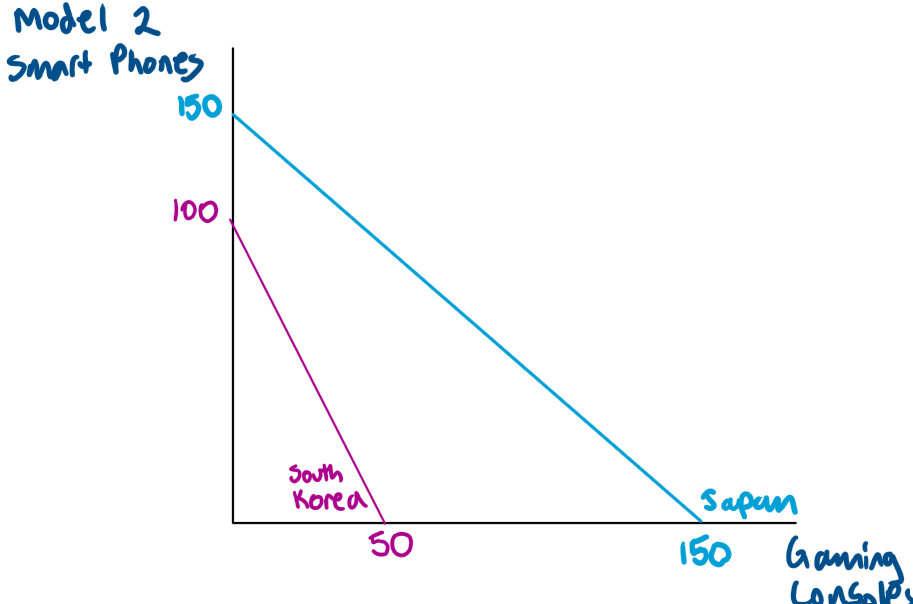
How do you Calculate a Suitable Terms of Trade:
Chose a rate that is between the opportunity cost of producing a good for two countries.
e.g., if in Australia the opportunity cost of producing 1 unit of wool is 0.5 units of shoes, while the opportunity cost for Bangladesh of 1 unit of wool is 2 units of shoes, therefore a suitable terms of trade could be 1 unit of wool trades for 1 unit of shoes.
What do you Discuss about when asked about the Sources of a Comparative Advantage:
Endowment of Natural Resources
Differences in Technology
Differences in Labour & Capital Resources
Differences in Labour & Capital Resources:
Differences in labour and capital resources give countries a comparative advantage by shaping what they can produce most efficiently. Nations with abundant low-cost labour, like Bangladesh, gain an advantage in labour-intensive industries such as textiles and footwear. In contrast, countries with highly skilled workers and advanced capital equipment, like Switzerland in watchmaking, Germany in automobiles, or the U.S. in aircraft and computers, specialise in high-quality, capital-intensive products. These differences allow nations to focus on industries that best match their resource base, fostering international trade and global specialisation.
Endowment of Natural Resources
An endowment of natural resources gives a country a comparative advantage by allowing it to produce certain goods more efficiently and at a lower opportunity cost than others. Countries rich in fertile land, minerals, or energy resources can specialise in producing and exporting these goods, while importing products they cannot produce as cheaply. For example, Australia’s abundance of farmland and minerals underpins its comparative advantage in agriculture and mining, enabling it to export primary products like iron ore, coal, and wheat. Meanwhile, resource-scarce countries often specialise in manufacturing, creating patterns of international trade based on differing natural endowments.
Differences in Technology:
Differences in technology create a comparative advantage by enabling countries to produce goods more efficiently through innovation, advanced processes, and specialised knowledge. Nations that invest heavily in research and development can improve productivity, reduce costs, and develop unique, high-value products. For example, the United States has gained a comparative advantage in computer software and hardware through its technological leadership, with firms like Apple and Microsoft dominating global markets. This technological edge allows such countries to specialise in high-tech industries while trading with others for goods they cannot produce as competitively.
Draw a CPF for the Following Question:
Australia:
Wool: 10 units
Shoes: 5 units
Bangladesh:
Wool: 5 units
Shoes: 10 units
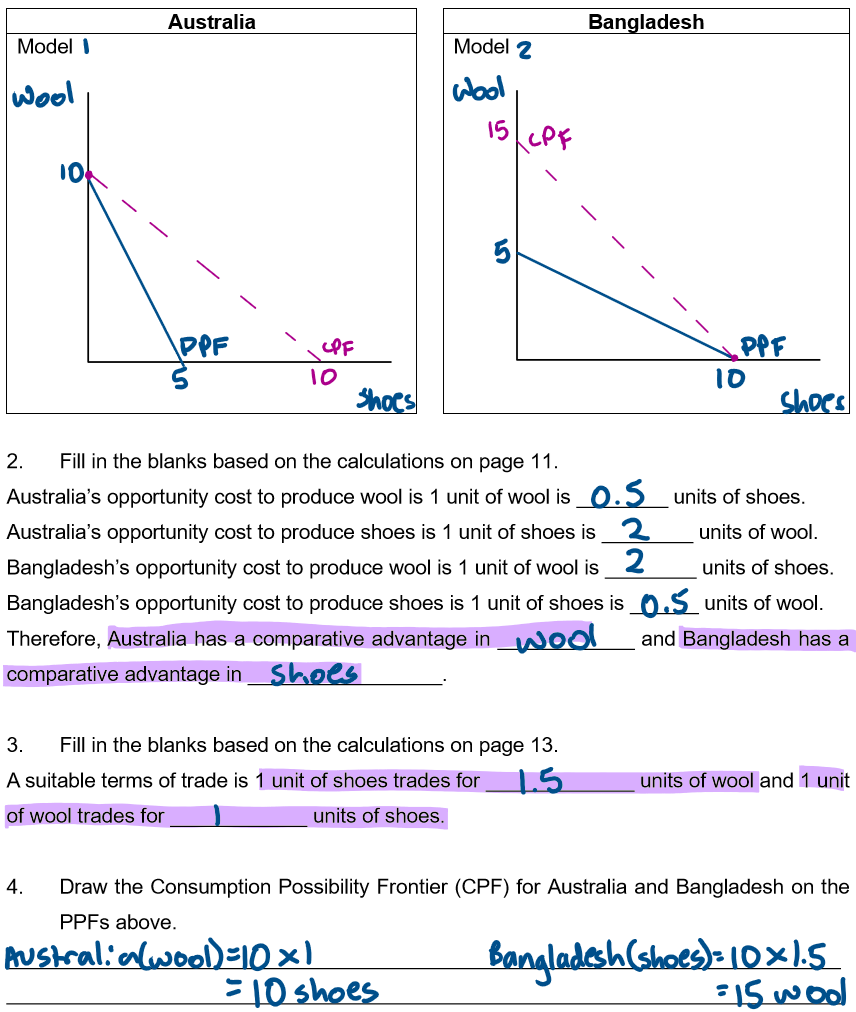

Draw a PPF for the Following Question using Output Data:
If Australia only produced wool its output would be 10 units if it used all its resources to produce just shoes its output would by 5.
If Bangladesh only produced wool its output would be 5 units if it used all its resources to produce just shoes, then its output would be 10.
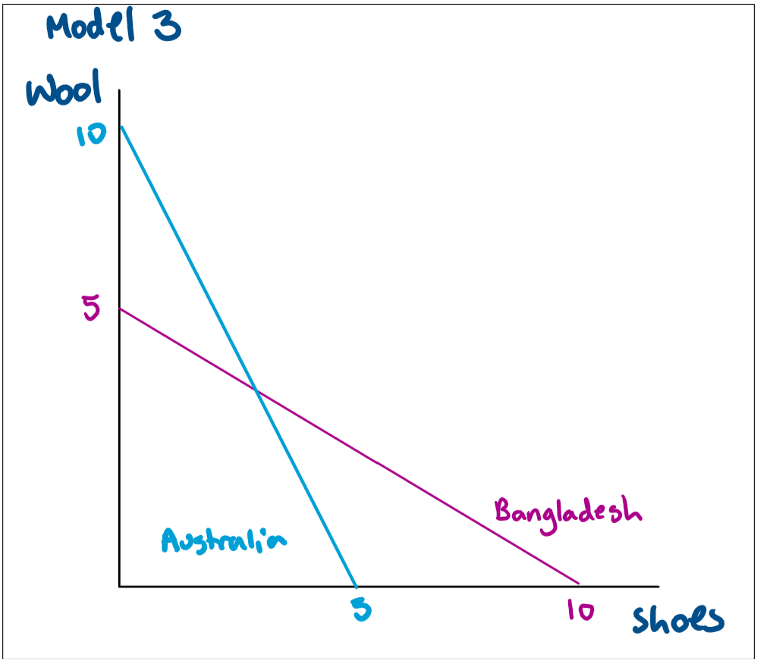

How to calculate absolute advantage using Input Data
When using input data, a country has an absolute advantage when it has the lowest amount of inputs.
according to the data France has the absolute advantage as it takes France less time.

How to convert inputs into outputs:
assume each country has 30 available input hours

Gains from Specialisation & Trade using Demand & Supply - Gains from Exports:
Definiton of Exports: The sale of domestically produced goods & services to overseas markets.
Exports are the sale of domestically produced goods & services to overseas markets, for example iron ore & coal. As seen in model 1 before trade equilibrium price is at Pd (domestic price) & equilibrium quantity is at Q1. Domestic consumption & production is at Q1.
Through trade, domestic producers can access higher prices for their products & price increases from Pd to Pw (world price). Domestic production increases from Q1 to Q3 & domestic consumption decreases from Q1 to Q2. There is now a surplus which is cleared by exporting overseas (Q3-Q2). producer surplus increases from DE to BCDEF & consumer surplus decreases from ABC to A. The net gain in total surplus is F increasing total surplus from ABCDE to ABCDEF. Since the gain in producer surplus is grater than the loss in consumer surplus, the Australian economy gains & economic welfare increases.
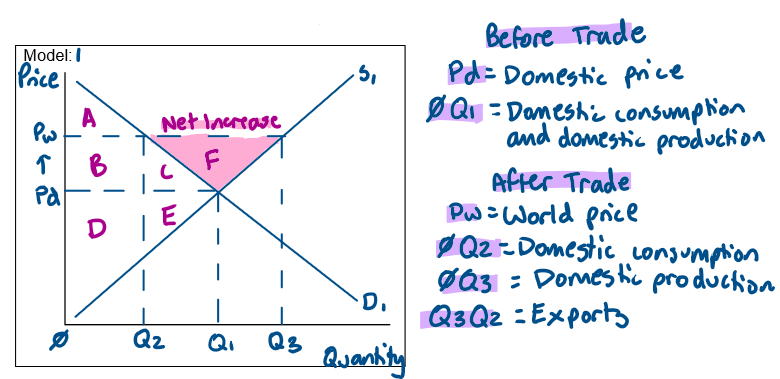
Gains from Specialisation & Trade using Demand & Supply - Gains from Imports:
Definition of Imports: Imports (pmvs, technology, telecommunications equipment) are the purchase of foreign goods & services produced overseas.
Imports refer to the purchase of foreign goods & services produced overseas for example PMVs. As seen in model 2 before trade equilibrium price is Pd (domestic price) & equilibrium quantity is Q1. Domestic production & consumption is at Q1.
Through trade, consumers can access a wider variety of products at cheaper prices therefore prices decrease from Pd to Pw (world price). Domestic consumption increases from Q1 to Q3 & domestic production decreases from Q1 to Q2. There is now a shortage which is cleared through importin from overseas (Q3-Q2). Producer surplus decreases from BC to C & consumer surplus increases from A to ABDE. The net gain in total surplus is DE increasing total surplus from ABC to ABCDE. Since the gain in consumer surplus is greater than the loss in producer surplus, the Australian economy gains & economic welfare increases.
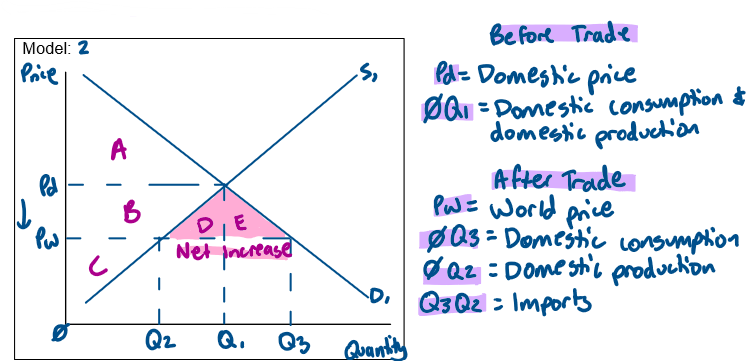
What do you Discuss when asked about the Benefits of Trade Liberalisation:
Economic Growth & Living Standards
Specialisation & comparative Advantage
Increased World Output & Efficiency
Access to a Wider Variety of Goods & Services
Economic Growth & living Standards as a Benefit of Trade Liberalisation:
Trade liberalisation benefits an economy by driving economic growth and improving living standards. Reducing trade barriers increases both imports and exports, expanding domestic industry output and raising production levels. This stimulates GDP growth—evident in the period of 1950–1973, when the fastest global trade growth coincided with the highest global economic growth. For Australia, trade liberalisation has made Real GDP 5.4% higher than it would otherwise have been.
Increased exports boost employment and incomes, while greater imports give consumers access to a wider range of low-cost, high-quality goods and services that may not be available domestically. Currently, 1 in 5 Australian workers (2.2 million people) are employed in trade-related activities, highlighting trade’s direct role in job creation and income growth. Together, these factors lift household purchasing power, improve welfare, and enhance overall living standards in Australia.
Specialisation & Comparative Advantage as a Benefit of Trade Liberalisation:
Trade liberalisation promotes specialisation and comparative advantage, leading to a more efficient allocation of global resources. By reducing barriers to trade, countries can focus on producing goods and services they are most efficient at, diverting resources to their most appropriate and productive use. This structural change increases both domestic and global output, as productivity rises when nations specialise.
For example, Australia has a comparative advantage in producing iron ore, coal, and education, which it exports, while importing goods where it lacks an advantage, such as passenger motor vehicles and refined petroleum. This efficient allocation of resources boosts total world output, raises productivity, and ensures that goods are produced at the lowest opportunity cost. Ultimately, specialisation through trade liberalisation enhances efficiency, output, and global economic welfare.
Increased World Output & Efficiency as a Benefit of Trade Liberalisation:
Trade liberalisation increases world output and efficiency by opening economies to global markets and fostering competition. When barriers are reduced, exporters supply to the world market and must compete internationally, which drives firms to lower production costs, raise quality, and use resources more effectively. This ensures that resources are not wasted, while consumers benefit from low-cost, high-quality goods.
As global output expands, countries can consume at a point beyond their Production Possibility Frontier (PPF), accessing goods and services that were previously unattainable. A clear example is the China–Australia Free Trade Agreement (ChAFTA), which lowered Chinese tariffs on Australian agricultural products such as meat, dairy, and wine. This boosted the competitiveness of Australian exports, increased production in these industries, and contributed to higher total world output. Thus, trade liberalisation enhances both efficiency and global welfare by pushing economies to operate at their most productive levels.
Access to a Wider Variety of Goods & Services as a Benefit of Trade Liberalisation:
Trade liberalisation improves access to a wider variety of goods and services, enabling countries to obtain products they cannot produce themselves or in sufficient quantities. Limited resources, such as land or technology, often make imports essential—for instance, countries without suitable land for grain import from Australia, while Australia imports manufactured goods like passenger motor vehicles (PMVs) that are not produced domestically.
By lowering barriers to trade, consumers gain greater choice and quality. In Australia, the average tariff rate fell from 7.3% in 1986 to less than 1% in 2016, which significantly boosted imports. As a result, annual merchandise imports rose from $40 billion to $265 billion, reflecting the growing access to affordable, high-quality goods from around the world. This wider variety enhances consumer welfare and overall living standards, making it a key benefit of trade liberalisation.
Definition of Tariff:
A government imposed tax on imports.
The Impact of Tariffs using the Demand & Supply Model on Trade, Market Efficiency & the Macroeconomy:
The Introduction of a Tariff
Tariff Definition: A government imposed tax on imports.
For example during the 1990s tariffs on clothing apparel imported into Australia peaked at 176%. In model 1, the implementation of a tariff causes an increase in price from Pw to T. This switches consumption away from imports to domestic goods & causes imports to decrease from Q1Q2 to Q3Q4. Due to the higher price domestic consumption decreases form Q2 to Q4. Domestic production increases form Q1 to Q3 & domestic producer revenue increases from Pw x Q1 to T x Q3. Foreign producer revenue increases from Pq x Q1 to T x Q3. Foreign producer revenue decreases from Pw(Q1-Q2) to Pw(Q4-Q3). Producer surplus increases from G to CG as they receive a higher price & sell a higher quantity. Consumer surplus will decrease from ABCDEF to AB as they pay a higher price & consumer a lower quantity. This results in a net welfare loss to the economy thus creating a deadweight loss of DF. This results in total surplus decreasing from ABCDEFG to ABCG meaning the market is inefficient & economic welfare decreases. The government revenue from the tariff is E. Producers who use the imported goods as inputs will suffer as tariffs increase their costs of production leading to cost push inflation. Domestic output & employment in the non-protected industries will decrease due to higher costs & resources being diverted away from these industries to the protected industries. On the other hand, as domestic producers increase production this will result in an increase in employment in these industries.
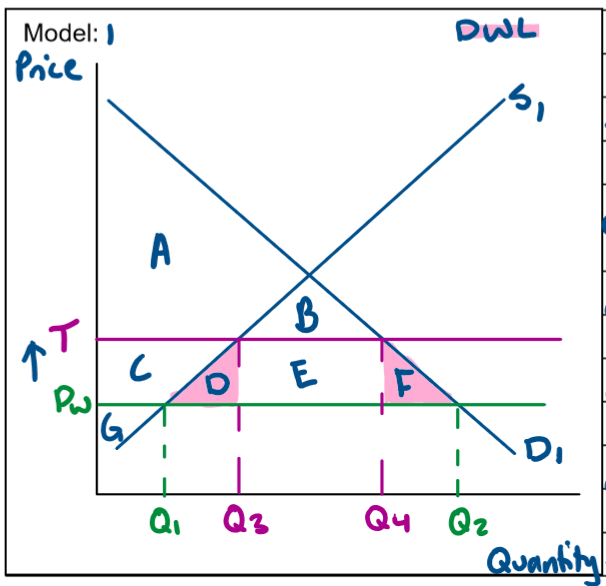
The Impact of Tariffs using the Demand & Supply Model on Trade, Market Efficiency & the Macroeconomy:
The Removal of a Tariff
Tariff Definition: A government imposed tax on imports.
A tariff is a government imposed tax on imports, for example during the 1990s tariffs on clothing apparel imported into Australia peaked at 176%. In model 2 the removal of a tariff causes a decrease in price from T to PW. This switches consumption away from domestic goods to imports & causes imports to increase from Q3Q4 to Q1Q2. Due to the lower price, consumption increases from Q4 to Q2. Due to the lower price consumption increases from Q4 to Q2. Domestic production decreases from Q3 to Q1 & domestic producer revenue decreases from T x Q3 to Pw x Q1. Foreign producer revenue increases from Pw (Q4-Q3) to Pw (Q1-Q2). Producer surplus decreases from GC to G as they receive a lower price & sell a lower quantity. Consumer surplus will increase from AB to ABCDEF as they pay a lower price & consume a larger quantity. This results in a net welfare gain to the economy thus eliminating the deadweight loss of DF. This results in an increase in total surplus from ABCG to ABCDEFG meaning the market is efficient & economic welfare increases. The government revenue from the tariff (E) is eliminated. Producers who use the imported goods as inputs will benefit as the removal of the tariff decreases their cost of production. Domestic output & employment will increase as resources are allocated to the most efficient industries, consequently there is an increase in production.
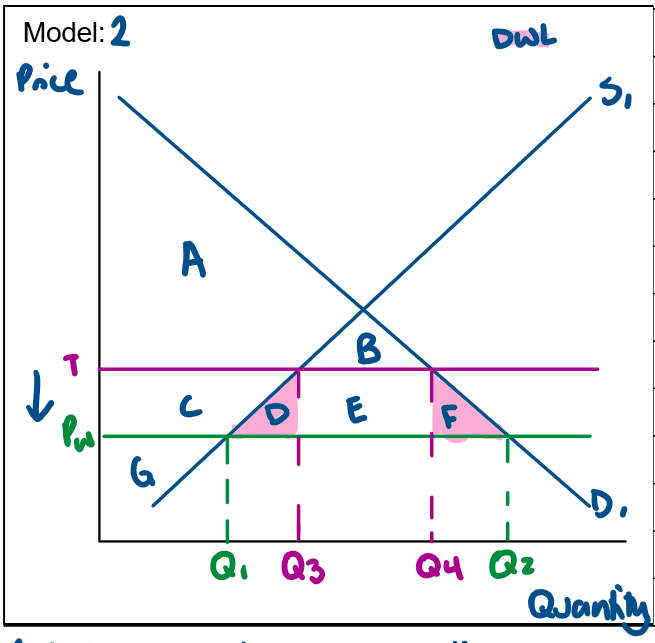
The Impact of Subsidies using the Demand & Supply Model on Trade, Market Efficiency & Market Efficiency:
The Introduction of a Subsidy
Subsidy Definition: Cash payments from governments to business to encourage the production of goods & service.
A subsidy is a cash payment from government to business to encourage the production of domestic goods & services. For example, the automotive transformation scheme for Australian car producers like holden & ford. In model 1, the implementation of a subsidy to domestic producers will shift the supply curve to the right from Sd to Ss as they receive the payment from the government & their cost of production decreases. This causes the price to remain the same at Pw. Domestic consumption remains unchanged at Q2 & imports decrease from Q1Q2 to Q3Q2. Domestic production increases from Q1 to Q3 & domestic producer revenue increases from Pw x Q1 to S x Q3. Foreign producer revenue decreases from Pw(Q2-Q1) to Pw(Q2-Q3). Government expenditure on the subsidy is SbcPw & producer surplus increases from Pwa∅ to Sb∅. Therefore the increase in producer surplus is less than the size of the subsidy which creates a deadweight loss at abc. As there is deadweight loss present, the market is inefficient & economic welfare decreases. Subsidies result in resource distortion as resources are diverted towards protected industries creating a high opportunity cost as it may not be the most efficient use of those resources. As domestic producers increase their production this will result in an increase in employment in these industries.
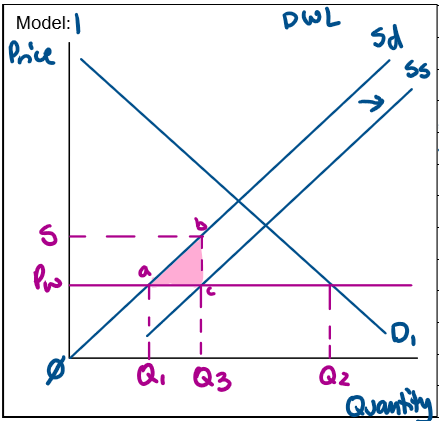
The Impact of Subsidies using the Demand & Supply Model on Trade, Market Efficiency & Market Efficiency:
The Removal of a Subsidy
Subsidy Definition: Cash payments from governments to business to encourage the production of goods & service.
A subsidy is a cash payment from governments to businesses to encourage the production of goods & services. For example the automotive transformation scheme to Australian car producers like Holden & Ford. In Model 2 the removal of a subsidy to domestic producers will shift the supply curve to the left from Ss to Sd as they no longer receive the payment from the government & their cost of production increases. This causes the price to remain the same at Pw. Domestic consumption remains unchanged at Q2 & imports increase from Q3Q2 to Q1Q2. Domestic production decreases from Q3 to Q1 & domestic producer revenue decreases from S x Q3 to Pw x Q1. Foreign producer revenue increases form Pw(Q2-Q3) to Pw(Q2-Q1). Government expenditure on the subsidy of SbcPw is eliminated & producer surplus decreases from Sb∅ to Pwa∅. This eliminate the deadweight loss that was present at abc & therefore the market is efficient & economic welfare increases. The removal of a subsidy results in the efficient allocation of resources as they are allocated to the most efficient industries. Short term the removal of a subsidy will result in structures unemployment as businesses seek to compete with the global market. In the long term these workers will retrain & enter into more efficient industries promoting economic growth.
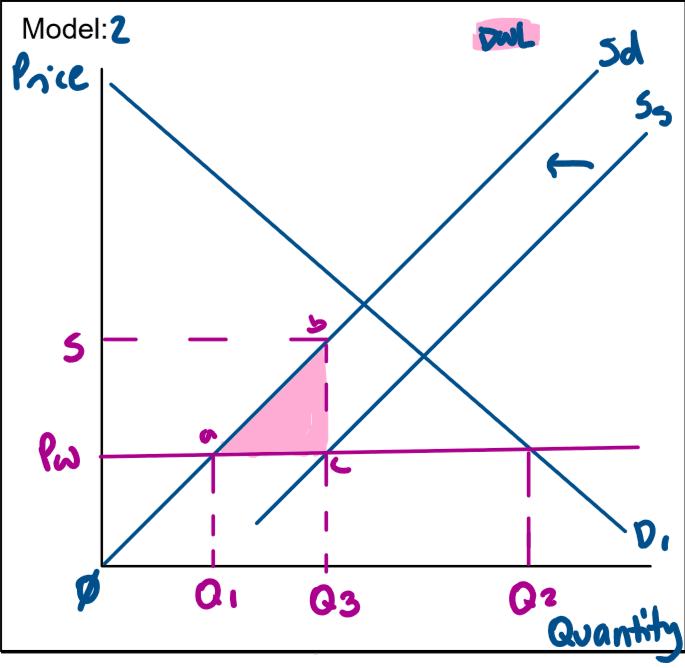
What do you Discuss when asked about Arguments for Protection:
In order of validity:
Prevention of Dumping Argument
Infant Industries Argument
National Security (Defence) Argument
Diversification Argument
Protection of Domestic Employment
Cheap Foreign Labour
Favourable Balance of Trade (Balance of Payments)
Evaluate Prevention of Dumping as an Argument for Protection:
Prevention of dumping provides a limited but valid argument for protection. Dumping occurs when exports are sold below their normal domestic price, often below cost, allowing larger firms to exploit economies of scale & engage in predatory pricing. This can force smaller domestic producers in importing countries out of business, creating a case for short-term protection through anti-dumping tariffs to maintain domestic industry viability & employment.
However, the effectiveness of this argument is weak in practice. Lower prices may simply reflect comparative advantage & specialisation, not unfair dumping, & proof is difficult due to limited access to foreign firms’ cost structures. For instance, China’s 2020 claim that Australia dumped barley & wine led to tariffs of 80% on barley & up to 218% on wine, yet many analysts considered these measures disguised protectionism rather than evidence-based.
Thus, while protection measures can correct market failure from predatory pricing, they are often misused, generating.
Evaluate Infant Industries as an Argument for Protection
Protection of infant industries is a valid but limited justification for protection. In theory, temporary protection allows new industries to establish themselves, achieve economies of scale, & develop a comparative advantage, enabling them to compete internationally once mature. This supports long-term economic growth & diversification, especially in developing economies.
However, risks arise when industries become dependent on protection. Shielded from competition, firms may lack incentives to innovate or improve efficiency, creating long-term inefficiencies & resource misallocation. This was evident in the Australian PMV (passenger motor vehicle) sector: from the mid-20th century, tariffs were imposed to protect local car manufacturers. Instead of becoming globally competitive, the sector became reliant on ongoing assistance, with tariff rates peaking at 57.5% in 1984. Even after reductions, the industry failed to achieve competitiveness, leading to the closure of Ford, Toyota, & Holden.
Therefore, while infant industry protection can be justified, it must be temporary, subject to review, & progressively reduced to avoid entrenched inefficiency. In practice, the risk of protection dependency undermines its effectiveness as a long-term argument for trade barriers.
Evaluate National Security (Defence) as an Argument for Protection:
National security is a valid but limited justification for protection. Certain industries are essential for a country’s ability to defend itself, meaning security considerations can take precedence over economic efficiency. Industries such as defence manufacturing, banking, communications, and agriculture are often deemed strategically important & may require protection from foreign dependence to ensure sovereignty during conflict.
However, a key limitation is defining which industries are truly vital, as almost any sector can claim strategic importance, creating potential for overuse of protectionist measures. Historically, this argument was prominent during World War II, & it remains relevant today. For example, the Australian defence manufacturing sector received substantial government support for the development of the Bushmaster armoured vehicles, funded by Australian Defence Industries, to maintain domestic capability.
Overall, while national security protection is justifiable in specific cases, its application must be carefully targeted, balancing security needs with economic efficiency to avoid unnecessary market distortion.
Evaluate Diversification as an Argument for Protection:
Diversification is generally a weak argument for protection. The idea is that by protecting industries in which a country lacks a comparative advantage, a nation can reduce dependence on a narrow range of exports and mitigate risk from global demand shocks or price volatility. For example, economies heavily reliant on a single commodity, like oil-dependent countries, may be vulnerable to sudden price falls.
However, this argument is limited in practice. Few, if any, countries specialise in only one or two products; even highly resource-dependent nations like Australia maintain a diversified export portfolio (agriculture, mining, services). Applying protection for diversification often reduces efficiency and gains from trade, as it discourages countries from exploiting their true comparative advantage.
Overall, while diversification may have some theoretical appeal for risk management, it is not a strong justification for trade protection.
Evaluate Protection of Domestic Employment as an Argument for Protection:
Protection of domestic employment is an invalid argument for trade protection. The argument claims that by restricting imports, consumer spending shifts to domestic goods, supporting jobs in protected industries. For example, tariffs on the Australian car manufacturing sector (Holden & Ford) were intended to safeguard local employment.
However, this approach creates net employment losses elsewhere in the economy. Higher prices for imported inputs raise production costs for other domestic firms, reducing competitiveness & household purchasing power. For instance, transport & logistics companies faced higher vehicle costs due to car tariffs, negatively affecting jobs in those sectors. Furthermore, protection can trigger retaliatory trade measures from other countries, potentially harming export industries.
Overall, while short-term job protection may occur in specific sectors, the overall economic cost & inefficiency make this argument weak.
Evaluate Cheap Foreign Labour as an Argument for Protection:
Favourable balance of trade is an invalid argument for protection. This argument assumes that a trade deficit (imports > exports) is harmful & a trade surplus (exports > imports) is beneficial, justifying restrictions on imports.
However, this is flawed as countries benefit from both imports & exports; restricting imports reduces consumer choice, raises costs, & can decrease exports by making domestic industries less competitive internationally. For example, tariffs on inputs for manufacturing increase production costs, undermining the competitiveness of Australian exporters. Empirical evidence shows that countries like Australia maintain long-term economic growth through open trade and balanced integration, rather than aiming for surpluses.
Overall, using a favourable balance of trade as a justification for protection ignores the gains from comparative advantage & specialisation, making it one of the weakest arguments for trade barriers.